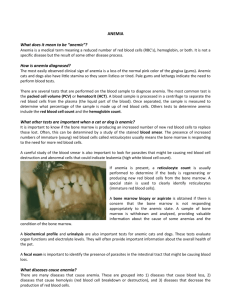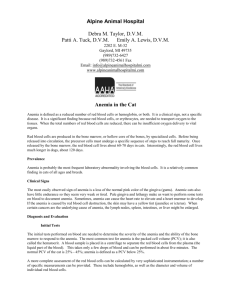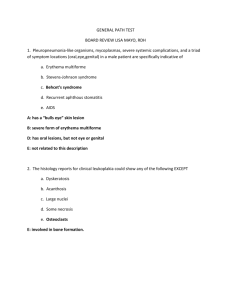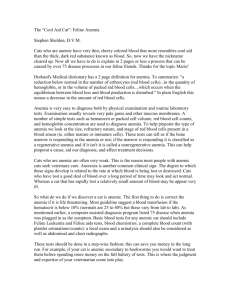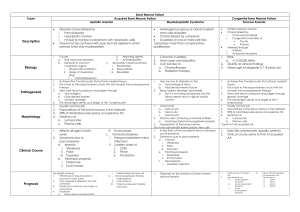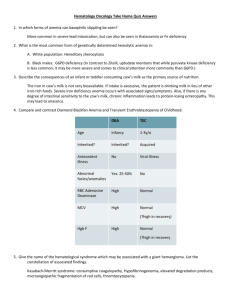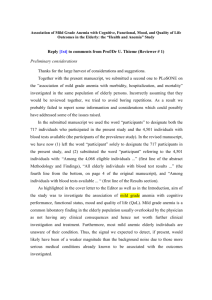ANEMIA IN THE CAT
advertisement
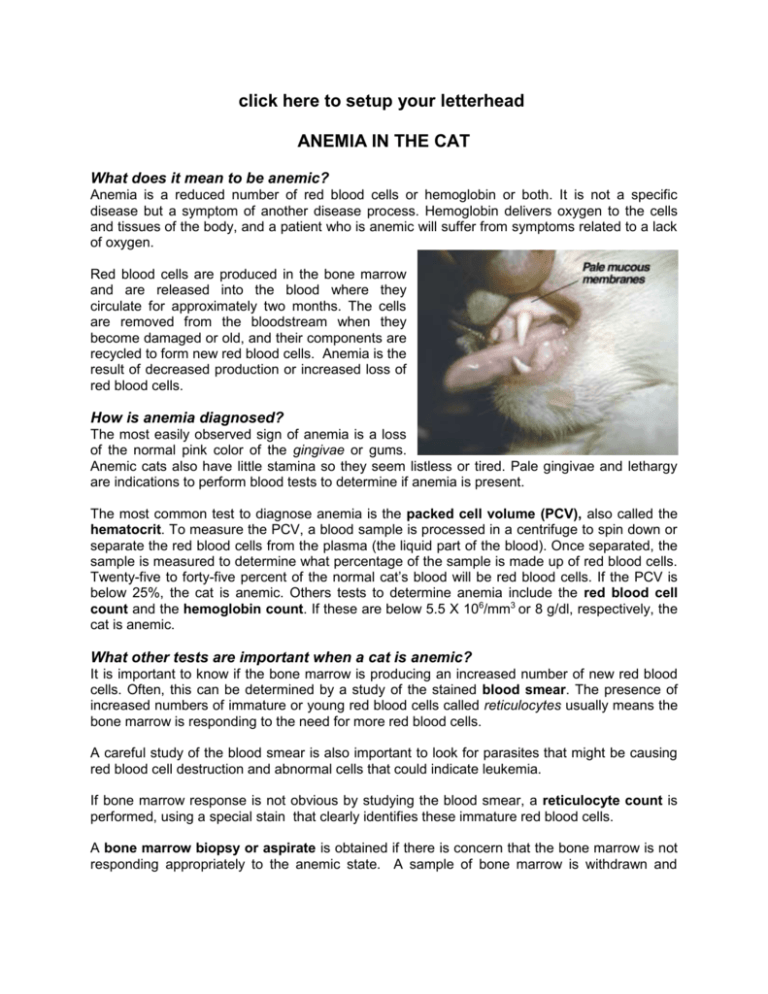
click here to setup your letterhead ANEMIA IN THE CAT What does it mean to be anemic? Anemia is a reduced number of red blood cells or hemoglobin or both. It is not a specific disease but a symptom of another disease process. Hemoglobin delivers oxygen to the cells and tissues of the body, and a patient who is anemic will suffer from symptoms related to a lack of oxygen. Red blood cells are produced in the bone marrow and are released into the blood where they circulate for approximately two months. The cells are removed from the bloodstream when they become damaged or old, and their components are recycled to form new red blood cells. Anemia is the result of decreased production or increased loss of red blood cells. How is anemia diagnosed? The most easily observed sign of anemia is a loss of the normal pink color of the gingivae or gums. Anemic cats also have little stamina so they seem listless or tired. Pale gingivae and lethargy are indications to perform blood tests to determine if anemia is present. The most common test to diagnose anemia is the packed cell volume (PCV), also called the hematocrit. To measure the PCV, a blood sample is processed in a centrifuge to spin down or separate the red blood cells from the plasma (the liquid part of the blood). Once separated, the sample is measured to determine what percentage of the sample is made up of red blood cells. Twenty-five to forty-five percent of the normal cat’s blood will be red blood cells. If the PCV is below 25%, the cat is anemic. Others tests to determine anemia include the red blood cell count and the hemoglobin count. If these are below 5.5 X 106/mm3 or 8 g/dl, respectively, the cat is anemic. What other tests are important when a cat is anemic? It is important to know if the bone marrow is producing an increased number of new red blood cells. Often, this can be determined by a study of the stained blood smear. The presence of increased numbers of immature or young red blood cells called reticulocytes usually means the bone marrow is responding to the need for more red blood cells. A careful study of the blood smear is also important to look for parasites that might be causing red blood cell destruction and abnormal cells that could indicate leukemia. If bone marrow response is not obvious by studying the blood smear, a reticulocyte count is performed, using a special stain that clearly identifies these immature red blood cells. A bone marrow biopsy or aspirate is obtained if there is concern that the bone marrow is not responding appropriately to the anemic state. A sample of bone marrow is withdrawn and analyzed, providing valuable information about the cause of some anemias and the condition of the bone marrow. A biochemical profile and urinalysis are other important tests for anemic cats. These tests evaluate organ function and electrolyte levels. They will often provide important information about the total health of the cat. A fecal exam is important to identify the presence of parasites in the intestinal tract that might be causing blood loss. Finally, an anemic cat should be tested for the feline leukemia virus (FeLV) and feline immunodeficiency virus (FIV) because these viruses are important causes of anemia. What diseases cause anemia? There are many diseases that cause a decrease in the number of red blood cells or hemoglobin. These are grouped into 1) diseases that cause blood loss, 2) diseases that cause hemolysis or red blood cell breakdown and destruction, and 3) diseases that decrease the production of red blood cells through bone marrow suppression. What diseases of cats cause blood loss? The main causes of blood loss in cats include: Trauma or injury t to blood vessels or internal organs resulting in bleeding Severe parasitic infestations with fleas, ticks, and hookworms Tumors of the intestinal tract, kidneys, and urinary bladder Diseases that prevent proper clotting of blood or damage or reduce the number of blood platelets What diseases of cats cause hemolysis? The main causes of hemolysis in cats include: Autoimmune disease Feline leukemia virus (FeLV) Blood parasites such as Hemobartonella Chemicals or toxins Neoplasia (cancer) What diseases of cats prevent red blood cell production through bone marrow suppression? The main causes of bone marrow suppression in cats include: Any severe or chronic disease Very poor nutrition or nutritional imbalances Autoimmune disease Feline leukemia virus (FeLV) Feline immunodeficiency virus (FIV) Chemicals or toxins Neoplasia (cancer) There has been no mention of iron deficiency anemia. Why not? Iron deficiency anemia is a common disease in people, especially women. However, this is not common in cats and only occurs secondary to chronic blood loss. How are anemic cats treated? If your cat’s anemia is life-threatening, a blood transfusion is needed. This may be performed immediately after a blood sample is taken for testing purposes. The main purpose of a blood transfusion is to stabilize the cat long enough that a determination of the cause of the anemia can be made. Further treatment will be determined once the underlying disease has been diagnosed. This client information sheet is based on material written by Ernest Ward, DVM © Copyright 2005 Lifelearn Inc. Used with permission under license. February 12, 2016
